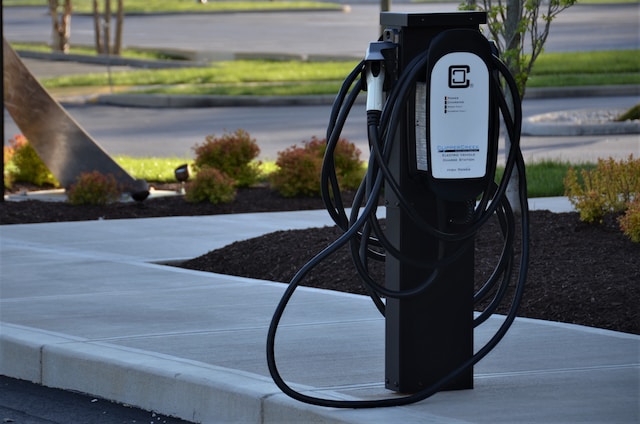
Definition and history of EVs
Electric Vehicles (EVs) are vehicles that use electric motors and batteries to power their drivetrains instead of internal combustion engines that run on fossil fuels. The term “electric vehicle” can refer to a wide range of vehicles, from cars and trucks to buses and trains.
The history of EVs dates back to the 1830s, when inventors began experimenting with electric-powered vehicles. The first successful electric car was built in the 1880s by Thomas Parker, a British inventor. However, it was not until the early 20th century that EVs began to gain popularity, particularly in urban areas.
The rise of gasoline-powered vehicles led to a decline in the use of EVs, but interest in electric vehicles was renewed in the 1990s as concerns about air pollution and climate change grew.
Types of EVs:
There are several types of electric vehicles (EVs), including:
- Battery Electric Vehicles (BEVs): These are EVs that are powered solely by an electric motor and a battery pack. BEVs have no internal combustion engine, and they must be charged by plugging them into an external power source. BEVs have no tailpipe emissions and are considered the most environmentally friendly type of EV.
- Plug-in Hybrid Electric Vehicles (PHEVs): These are EVs that have both an electric motor and an internal combustion engine. PHEVs can operate on either electricity or gasoline, and they can be charged from an external power source or by using the internal combustion engine. PHEVs have lower emissions than traditional gasoline-powered vehicles, but they are not as environmentally friendly as BEVs.
- Hybrid Electric Vehicles (HEVs): These are EVs that have both an electric motor and an internal combustion engine, but the electric motor is not powerful enough to drive the vehicle on its own. Instead, the electric motor assists the internal combustion engine to improve fuel efficiency and reduce emissions.
- Fuel Cell Electric Vehicles (FCEVs): These are EVs that use hydrogen fuel cells to generate electricity to power an electric motor. FCEVs emit only water vapor and have the potential to be very environmentally friendly, but the availability of hydrogen fueling stations is limited, and the cost of producing hydrogen fuel is high.
Each type of EV has its own advantages and disadvantages, and the best type of EV for a particular person will depend on their needs and preferences.

EV Charging Infrastructure
EV charging infrastructure refers to the network of charging stations that are used to charge electric vehicles. Find out various types of charging stations are available, such as:
Types of charging stations:
There are three main types of charging stations used for electric vehicles:
- Level 1 Charging: This is the simplest and slowest form of charging and uses a standard 120-volt household outlet to charge the vehicle. It provides an average of 2-5 miles of range per hour of charging, and it is typically used for home charging or when an EV is parked for an extended period.
- Level 2 Charging: This type of charging uses a 240-volt outlet and provides an average of 10-30 miles of range per hour of charging, depending on the vehicle and charging station. Level 2 charging is faster than Level 1 charging and is commonly used for home and public charging stations.
- Level 3 Charging (also known as DC Fast Charging): This is the fastest form of charging and uses a high-powered charging station with direct current (DC) to charge the vehicle rapidly. Level 3 charging can provide up to 80% of the vehicle’s range in as little as 20-30 minutes, but it requires specialized charging infrastructure and is typically only available at public charging stations.
Each of these charging levels has different charging times and power requirements. Level 1 and Level 2 charging stations are commonly used for home and public charging, while Level 3 charging is typically used for fast charging on long-distance trips or at public charging stations in high-traffic areas. The type of charging station used will depend on the vehicle and the charging needs of the driver.
Charging time and range
The charging time and range of an electric vehicle (EV) depend on several factors, including the type of EV, the size of the battery, and the charging level and speed.
Charging Time:
- Level 1 Charging: Provides an average of 2-5 miles of range per hour of charging. It can take up to 12-24 hours to fully charge an EV with a Level 1 charger, depending on the size of the battery.
- Level 2 Charging: Provides an average of 10-30 miles of range per hour of charging. It can take anywhere from 3-8 hours to fully charge an EV with a Level 2 charger, depending on the size of the battery and the charging speed.
- Level 3 Charging: Provides up to 80% of the vehicle’s range in as little as 20-30 minutes, but it requires specialized charging infrastructure and is typically only available at public charging stations.
Range:
An EV’s range refers to the distance it can cover on a single charge. The range of an EV varies based on several factors, including the size of the battery, the driving style, and the weather conditions. The following are the ranges of some popular electric vehicles:
- Tesla Model S: up to 375 miles on a single charge
- Chevrolet Bolt EV: up to 259 miles on a single charge
- Nissan Leaf: up to 150 miles on a single charge
- Ford Mustang Mach-E: up to 300 miles on a single charge
- Audi e-tron: up to 222 miles on a single charge
It is important to note that the range of an EV is an estimate and may vary based on driving conditions and other factors. EV manufacturers are constantly improving battery technology to increase the range and reduce the charging time of their vehicles.

Public vs. private charging infrastructure
Public and private charging infrastructure refer to the types of charging stations available for electric vehicles (EVs) and where they are located.
Public charging infrastructure includes charging stations that are available for use by the general public, typically located in public places such as parking garages, shopping malls, and on-street parking spaces. These charging stations are often operated by third-party companies and can be accessed through various payment methods, such as credit cards or mobile apps. Public charging stations are essential for EV drivers who need to recharge their vehicles when they are away from home or work.
Private charging infrastructure refers to charging stations that are installed at a private residence or business, typically for the use of the property owner or employees. Private charging infrastructure is often used for home charging, allowing EV drivers to charge their vehicles overnight or during off-peak hours when electricity rates are lower. Private charging infrastructure can also be installed at workplaces to provide charging options for employees who drive EVs.
While both public and private charging infrastructure are important for the widespread adoption of EVs, there are some differences between them. Public charging infrastructure is typically faster and more powerful than private charging infrastructure, as it is designed to support a higher volume of users. However, public charging infrastructure is often more expensive to use and may require additional time for travel and waiting. Private charging infrastructure, on the other hand, is often more convenient and cost-effective for EV drivers who have access to it, as it can be used for overnight or off-peak charging without the need for additional travel or waiting.
Challenges and opportunities for expanding charging infrastructure
Expanding the charging infrastructure for electric vehicles (EVs) is essential to increasing the adoption of EVs and reducing greenhouse gas emissions from transportation. However, there are several challenges and opportunities associated with expanding the charging infrastructure.
Challenges:
- High cost: Installing charging infrastructure can be expensive, particularly for fast-charging stations that require high power levels and specialized equipment.
- Limited availability of charging locations: Some areas may not have enough public charging stations to meet the needs of EV drivers, which can create a barrier to adoption.
- Range anxiety: Drivers may be hesitant to purchase an EV if they are concerned about the availability of charging stations and the distance they can travel on a single charge.
- Regulatory barriers: Some states or municipalities may have regulatory barriers that make it difficult or expensive to install public charging stations.
Opportunities:
- Government incentives: Governments can incentivize the installation of charging infrastructure through grants, tax credits, and other financial incentives.
- Private investment: Private companies can invest in charging infrastructure to meet the growing demand for EVs and to generate revenue from charging fees.
- Smart charging solutions: Smart charging solutions, such as demand response programs and vehicle-to-grid technology, can help to optimize the use of charging infrastructure and reduce costs.
- Public-private partnerships: Collaboration between governments, utilities, and private companies can help to overcome regulatory barriers and increase the availability of charging infrastructure.
- Renewable energy integration: Charging infrastructure can be powered by renewable energy sources such as solar and wind, reducing the carbon footprint of EVs and helping to meet climate goals.
Expanding the charging infrastructure for EVs will require a coordinated effort from government, private companies, and utilities to overcome the challenges and take advantage of the opportunities presented by this growing industry.
EV Batteries and Energy Storage
Electric vehicle (EV) batteries are the most critical component of an electric vehicle. They store the energy that powers the electric motor and determine the vehicle’s range, charging time, and performance.
EV batteries typically use lithium-ion technology, which is currently the most efficient and widely used battery technology for EVs. Lithium-ion batteries possess high energy density, making them an ideal choice for EVs as they can store a significant amount of energy in a limited space.
In addition to powering EVs, EV batteries can also be used for energy storage, a process known as stationary energy storage. Stationary energy storage involves storing energy in batteries when it is cheap and abundant and then using it when demand is high or when renewable energy sources are not available. Stationary energy storage can help to reduce peak demand on the electrical grid, stabilize grid frequency, and integrate renewable energy sources into the grid.
However, there are challenges associated with EV batteries and energy storage, including:
- Cost: EV batteries and energy storage systems can be expensive, which can increase the cost of EVs and make energy storage less economically viable.
- Durability and lifespan: The durability and lifespan of EV batteries are critical factors that affect the cost and sustainability of EVs and energy storage systems.
- Safety: Lithium-ion batteries can be dangerous if they are not handled properly, and the risk of fire or explosion increases as the battery ages.
- Recycling: EV batteries contain valuable materials such as lithium, cobalt, and nickel, but recycling these materials can be expensive and complex.
To overcome these challenges, researchers and manufacturers are working to develop new battery chemistries and manufacturing processes that can improve the performance, lifespan, and safety of EV batteries while reducing costs. In addition, governments and industries are investing in research and development, as well as infrastructure and policies, to support the growth of EVs and stationary energy storage.
Types of batteries used in EVs
The vast majority of electric vehicles (EVs) on the market today use lithium-ion batteries, which offer high energy density, fast charging times, and good overall performance. However, there are several other types of batteries that have been used or are being developed for use in EVs, including:
- Nickel-metal hydride (NiMH) batteries: NiMH batteries were commonly used in early hybrid electric vehicles (HEVs) such as the Toyota Prius. They are less expensive than lithium-ion batteries but have a lower energy density and a shorter lifespan.
- Solid-state batteries: Solid-state batteries are a promising new battery technology that use a solid electrolyte instead of a liquid electrolyte, which makes them safer, more durable, and potentially higher in energy density than lithium-ion batteries. However, solid-state batteries are still in the early stages of development and are not yet widely available.
- Zinc-air batteries: Zinc-air batteries use oxygen from the air as a reactant, which makes them lighter and less expensive than other battery types. They have a high energy density and are potentially recyclable. However, zinc-air batteries have lower power density and require air to be constantly supplied, making them less suitable for EVs.
- Sodium-ion batteries: Sodium-ion batteries use sodium ions instead of lithium ions as the charge carrier, which makes them potentially lower in cost and more environmentally friendly than lithium-ion batteries. However, sodium-ion batteries are still in the early stages of development and have lower energy density and lower cycling stability than lithium-ion batteries.
Lithium-ion batteries remain the dominant battery technology used in EVs, but researchers and manufacturers are actively exploring new battery chemistries and manufacturing processes that can improve battery performance, lifespan, and cost while reducing environmental impact.
Battery performance and durability
Battery performance and durability are crucial factors for the long-term viability and sustainability of electric vehicles (EVs). Batteries must be able to provide sufficient energy to power the vehicle and last for many years of use.
Here are some key factors that affect battery performance and durability:
- Energy density: Battery energy density is a measure of how much energy a battery can store per unit of volume or weight. Batteries with higher energy density can provide more energy for a given size or weight, which is important for EVs, where weight and space are critical factors.
- Charging speed: Battery charging speed is a measure of how quickly a battery can be charged from empty to full. Faster charging speeds can help to reduce charging time and improve the convenience of EVs.
- Temperature sensitivity: Batteries are sensitive to temperature, and high or low temperatures can affect battery performance and lifespan. Battery management systems (BMS) can help to regulate temperature and optimize battery performance.
- Cycle life: The cycle life of a battery refers to the number of charge and discharge cycles it can undergo before its performance deteriorates. Batteries with longer cycle life are more durable and can last longer, which is important for EVs that are expected to have a long lifespan.
- Depth of discharge: The depth of discharge (DOD) refers to how much of the battery’s capacity is used during each charge and discharge cycle. Batteries that are frequently discharged to a high DOD may have a shorter lifespan than those that are discharged to a lower DOD.
Improving battery performance and durability is a key area of research and development in the EV industry. Manufacturers are working to develop new battery chemistries, manufacturing processes, and battery management systems that can improve energy density, charging speed, temperature sensitivity, cycle life, and DOD, while reducing costs and environmental impact.
Battery recycling and end-of-life management
Battery recycling and end-of-life management are important considerations for the sustainability of electric vehicles (EVs) and the battery industry as a whole. Recycling batteries helps to recover valuable materials, reduce waste, and minimize the environmental impact of battery production and disposal.
Here are some key considerations for battery recycling and end-of-life management:
- Battery recycling: Recycling batteries involves recovering valuable materials such as lithium, cobalt, nickel, and aluminum, which can be reused to produce new batteries or other products. Recycling also helps to reduce the environmental impact of mining and extraction of these materials. Many battery manufacturers have established recycling programs, and regulations such as the EU Battery Regulation require battery producers to collect and recycle a certain percentage of their batteries.
- End-of-life management: Proper end-of-life management of batteries involves ensuring that batteries are disposed of safely and responsibly. Batteries can pose a risk to the environment if not disposed of properly, as they may leak toxic chemicals and heavy metals. Battery management systems (BMS) can help to monitor battery health and determine when a battery has reached the end of its useful life.
- Second-life use: Some batteries that have reached the end of their useful life in EVs may still have enough capacity to be used for other applications, such as energy storage in buildings or for grid-scale storage. This is known as second-life use and can help to extend the useful life of batteries and reduce waste.
- Battery design: Battery design can also play a role in battery recycling and end-of-life management. Designing batteries that are easily disassembled and have fewer materials that need to be separated can make recycling more efficient and cost-effective.
Battery recycling and end-of-life management are important considerations for the sustainability of EVs and the battery industry. Manufacturers, regulators, and consumers all have a role to play in ensuring that batteries are recycled properly and that end-of-life management is carried out safely and responsibly.
Energy storage solutions for grid integration
Energy storage solutions are becoming increasingly important for grid integration, as renewable energy sources such as solar and wind become more prevalent. Energy storage can help to balance the supply and demand of electricity, provide backup power during outages, and reduce the need for expensive infrastructure upgrades.
Here are some energy storage solutions for grid integration:
- Lithium-ion batteries: Lithium-ion batteries are the most commonly used type of battery for energy storage, due to their high energy density, fast charging times, and long cycle life. They can be used for grid-scale storage and are also used in EVs and other applications.
- Pumped hydro storage: Pumped hydro storage involves pumping water to a higher elevation during times of low demand, and then releasing it to generate electricity during times of high demand. This technology has been used for decades and is currently the largest form of energy storage in the world.
- Compressed air energy storage (CAES): CAES involves compressing air and storing it in underground caverns or tanks, and then using the compressed air to generate electricity when needed. This technology can provide large-scale energy storage and is particularly suitable for locations with underground geological formations that can be used for storage.
- Flow batteries: Flow batteries use two tanks of electrolyte, which are pumped through a membrane to generate electricity. They have the advantage of being able to store large amounts of energy for long periods of time, making them suitable for grid-scale storage.
- Thermal storage: Thermal storage involves using materials such as molten salt or ice to store heat or cold, which can then be used to generate electricity or provide heating and cooling. This technology can be used in combination with renewable energy sources such as solar or wind to provide round-the-clock power.
Energy storage solutions are becoming increasingly important for grid integration, as they can help to balance the supply and demand of electricity, reduce the need for expensive infrastructure upgrades, and provide backup power during outages. A range of energy storage technologies are available, each with its own advantages and disadvantages depending on the specific application.
EV Market and Industry Trends
The electric vehicle (EV) market has been rapidly growing in recent years, driven by a range of factors including government incentives, declining battery costs, and increased consumer awareness of environmental issues. Here are some of the key market and industry trends:
- Increasing market share: EVs are gaining market share in many parts of the world, particularly in Europe and China. According to the International Energy Agency, EV sales increased by 41% in 2020, despite the COVID-19 pandemic.
- Diversification of EV models: As EV technology has improved, automakers have been introducing more models to their lineups, from small city cars to luxury SUVs. This diversification is helping to expand the appeal of EVs to a wider range of consumers.
- Range and charging infrastructure: Improvements in battery technology have led to longer driving ranges for EVs, making them more practical for everyday use. Meanwhile, the expansion of charging infrastructure is helping to alleviate range anxiety and make EVs more convenient to own.
- Government incentives: Many governments around the world offer incentives for EV purchases, such as tax credits or rebates. These incentives help to make EVs more affordable and incentivize consumers to make the switch.
- Sustainability and circular economy: The EV industry is increasingly focused on sustainability and circular economy principles, with a growing emphasis on recycling and end-of-life management for batteries, and the use of renewable energy in EV production.
- Partnerships and collaborations: Automakers, tech companies, and other stakeholders in the EV industry are forming partnerships and collaborations to accelerate the development and adoption of EVs. For example, automakers are partnering with battery manufacturers to secure supply chains and develop new technologies.
The EV market and industry are experiencing rapid growth and innovation, driven by a range of factors including government incentives, technological advancements, and growing consumer demand. As the EV market continues to evolve, it is likely that we will see continued investment and development in the industry, with a focus on sustainability and innovation.
Global and regional EV sales and market share
Global and regional EV sales and market share have been increasing rapidly in recent years, driven by a range of factors including government incentives, declining battery costs, and increased consumer awareness of environmental issues. Here are some of the latest figures:
- Global EV sales: According to the International Energy Agency, global EV sales reached a record high of 3.1 million in 2020, up from 2.2 million in 2019. This represents an increase of 41%.
- Regional EV sales: China is the largest market for EVs, accounting for around 50% of global EV sales in 2020. Europe is the second-largest market, with EV sales increasing by 137% in 2020 compared to the previous year. The United States is the third-largest market, with EV sales increasing by 4% in 2020.
- Market share: EVs currently represent a small percentage of total vehicle sales, but this is increasing rapidly. In Europe, for example, EVs accounted for 10.5% of total vehicle sales in 2020, up from 3.5% in 2019. In China, EVs accounted for around 5% of total vehicle sales in 2020.
- Leading EV models: The Tesla Model 3 is the world’s best-selling EV, with sales of around 365,000 units in 2020. Other popular models include the Volkswagen ID.3, the Renault Zoe, and the Tesla Model Y.
- Growth projections: Analysts expect continued growth in the global EV market, with some predicting that EVs could account for up to 50% of new vehicle sales by 2030. China and Europe are expected to continue to be the largest markets for EVs, while the United States is expected to see significant growth in the coming years.
The global and regional EV markets are experiencing rapid growth, driven by a range of factors including government incentives, technological advancements, and growing consumer demand. As the market continues to evolve, it is likely that we will see continued investment and development in the industry, with a focus on sustainability and innovation.
Government policies and incentives for EV adoption
Government policies and incentives have played a significant role in promoting the adoption of electric vehicles (EVs) around the world. Here are some of the key policies and incentives that governments have implemented to encourage the transition to EVs:
- Purchase incentives: Many governments offer purchase incentives for EVs, such as tax credits, rebates, or direct subsidies. These incentives help to reduce the upfront cost of EVs, making them more affordable for consumers.
- Charging infrastructure: Governments are investing in charging infrastructure to increase the availability and accessibility of charging stations. This includes the installation of public charging stations in urban areas, along highways, and at workplaces.
- Zero-emission vehicle mandates: Some governments have implemented regulations requiring automakers to produce a certain percentage of zero-emission vehicles, such as EVs, in their fleets. This helps to stimulate the development and production of EVs.
- Emissions standards: Governments are implementing stricter emissions standards for vehicles, which encourages automakers to produce more fuel-efficient and low-emission vehicles, including EVs.
- Low-emission zones: Some cities have implemented low-emission zones, which restrict the access of high-emission vehicles, such as diesel cars, in certain areas. This helps to reduce air pollution and incentivize the use of low-emission vehicles, including EVs.
- Research and development funding: Governments are investing in research and development of EV technology, including battery technology and charging infrastructure. This helps to drive innovation and reduce the costs of EVs.
Government policies and incentives have been crucial in promoting the adoption of EVs around the world. These policies help to address some of the key barriers to adoption, such as high upfront costs and lack of charging infrastructure, and encourage consumers to make the switch to EVs. As the market for EVs continues to evolve, it is likely that we will see continued investment and innovation in government policies and incentives to further promote the adoption of EVs.
EV industry landscape and major players
The EV industry landscape is rapidly evolving, with a growing number of players entering the market and established automakers ramping up their EV production. Here are some of the major players in the EV industry:
- Tesla: Tesla is a leading player in the EV market, known for its popular and high-performance EV models such as the Model S, Model 3, and Model X. The company also produces battery technology and solar energy products.
- Volkswagen Group: Volkswagen Group is a major automaker that has committed to producing a large number of EV models in the coming years. The company’s brands include Volkswagen, Audi, Porsche, and others.
- General Motors: General Motors has set an ambitious goal of selling only zero-emissions vehicles by 2035, and has invested heavily in EV development. The company’s flagship EV model is the Chevrolet Bolt.
- Ford: Ford has committed to investing $22 billion in EV development through 2025, with a focus on electric SUVs and trucks. The company’s first mass-market EV model is the Mustang Mach-E.
- Nissan: Nissan was an early adopter of EV technology, producing the Nissan Leaf, one of the first mass-market EV models. The company is now working on developing next-generation EV technology and infrastructure.
- BMW: BMW has invested heavily in EV development and production, with its flagship EV models being the i3 and i8. The company has committed to producing 25 new EV models by 2025.
- Hyundai/Kia: Hyundai and its sister company Kia have invested heavily in EV development, with a goal of producing 23 new EV models by 2025. The companies’ flagship EV models include the Hyundai Kona Electric and the Kia Niro EV.
- Chinese automakers: Chinese automakers such as BYD, NIO, and Xpeng are emerging as major players in the EV market, with strong government support and a growing domestic market for EVs.
The EV industry is a rapidly evolving landscape, with established automakers and new entrants alike investing heavily in EV development and production. As the market for EVs continues to grow, we can expect to see further innovation and competition in the industry, with a focus on developing more affordable and accessible EV models, improving charging infrastructure, and advancing battery technology.
EV technology and innovation
EV technology and innovation have been key drivers in the rapid growth of the EV industry in recent years. Here are some of the key areas of technology and innovation in the EV industry:
- Battery technology: Advances in battery technology have enabled EVs to have longer ranges and faster charging times. Lithium-ion batteries are currently the most common type of battery used in EVs, but researchers are exploring new battery chemistries, such as solid-state batteries and lithium-sulfur batteries, that could offer even greater performance and safety.
- Charging infrastructure: Improvements in charging infrastructure are helping to address one of the key barriers to EV adoption: range anxiety. High-speed DC fast charging stations are becoming more widely available, and researchers are exploring wireless charging technologies that could make EV charging even more convenient.
- Lightweight materials: EVs require lightweight materials to maximize range and performance. Carbon fiber, aluminum, and other lightweight materials are being used to reduce the weight of EVs while maintaining safety and durability.
- Autonomous driving technology: EVs are well-suited to autonomous driving technology, and many EV models already offer advanced driver assistance features. As autonomous driving technology continues to advance, we can expect to see more EV models with self-driving capabilities.
- Energy storage solutions: EV batteries can also be used for energy storage, helping to balance the electricity grid and increase the use of renewable energy sources. Researchers are exploring new energy storage solutions, such as vehicle-to-grid technology and second-life batteries, that could make EVs even more valuable for grid integration.
Technology and innovation are driving the rapid growth of the EV industry, with advances in battery technology, charging infrastructure, lightweight materials, autonomous driving technology, and energy storage solutions helping to make EVs more practical, affordable, and accessible for consumers. As the EV industry continues to evolve, we can expect to see further advances in these and other areas of technology and innovation, paving the way for a more sustainable and efficient transportation system.
Environmental and Social Impact of EVs
EVs have the potential to offer significant environmental and social benefits, but they also come with their own set of environmental and social impacts. Below are some of the significant effects of EVs:
Environmental impacts:
- Greenhouse gas emissions: EVs produce fewer greenhouse gas emissions than gasoline and diesel-powered vehicles, especially when they are charged with renewable energy sources such as wind and solar power. This can help reduce the impact of transportation on climate change.
- Air pollution: EVs produce no tailpipe emissions, which can help improve air quality in urban areas. However, the production of electricity used to charge EVs can still produce air pollution if it is generated from fossil fuels.
- Resource depletion: The production of EVs requires the use of rare earth metals and other natural resources, which can have negative environmental impacts if they are not sourced responsibly. However, recycling and responsible sourcing of these materials can help minimize the impact of EV production.
Social impacts:
- Employment: The growth of the EV industry can create new job opportunities in manufacturing, research and development, and other areas. However, it can also lead to job losses in the traditional automotive industry.
- Access: EVs can help improve access to transportation for people who live in areas with limited public transportation options or who cannot afford to own a car. However, the high cost of EVs can make them inaccessible to many people.
- Disposal: EV batteries contain hazardous materials, which can pose a risk to human health and the environment if they are not disposed of properly. However, advances in battery recycling technology are helping to reduce the environmental impact of battery disposal.
EVs offer the potential for significant environmental and social benefits, but they also come with their own set of environmental and social impacts that must be carefully managed. As the EV industry continues to grow, it will be important to address these impacts and ensure that EVs are developed and used in a sustainable and responsible manner.
Greenhouse gas emissions and air pollution reduction
One of the main environmental benefits of EVs is their potential to reduce greenhouse gas emissions and air pollution. Here are some of the ways in which EVs can help reduce these impacts:
- Reduced greenhouse gas emissions: EVs produce significantly fewer greenhouse gas emissions than gasoline and diesel-powered vehicles. According to the Union of Concerned Scientists, EVs produce about half as much greenhouse gas emissions over their lifetime as a gasoline-powered car that gets 27 miles per gallon.
- Improved air quality: EVs produce no tailpipe emissions, which can help improve air quality in urban areas. This is particularly important for reducing the impact of transportation on public health, as air pollution is linked to a range of health issues, including respiratory problems and heart disease.
- Renewable energy sources: When EVs are charged with electricity generated from renewable energy sources, such as wind and solar power, their greenhouse gas emissions are virtually eliminated. This can help reduce the environmental impact of transportation even further.
- Efficiency gains: EVs are generally more energy-efficient than gasoline and diesel-powered vehicles, which means they require less energy to travel the same distance. This can help reduce the environmental impact of transportation and reduce the overall demand for energy.
EVs have the potential to significantly reduce greenhouse gas emissions and air pollution, particularly when they are charged with renewable energy sources. However, it is important to consider the entire life cycle of EVs, including the production and disposal of their batteries, to ensure that they are developed and used in a sustainable and responsible manner.
Lifecycle analysis and carbon footprint of EVs
Lifecycle analysis (LCA) is a tool used to assess the environmental impacts of a product or system over its entire life cycle, from raw material extraction to disposal. LCA can be used to estimate the carbon footprint of EVs and compare them to other types of vehicles. Here are some of the key findings from LCAs of EVs:
- Manufacturing: The production of EVs requires more energy and produces more greenhouse gas emissions than the production of gasoline-powered vehicles. However, the higher efficiency of EVs means that these emissions are offset over the lifetime of the vehicle.
- Use: EVs produce significantly fewer greenhouse gas emissions during use than gasoline-powered vehicles, particularly when they are charged with electricity from renewable sources.
- Disposal: EV batteries contain materials that can be hazardous to the environment if they are not disposed of properly. However, advances in battery recycling technology are helping to reduce the environmental impact of battery disposal.
LCAs suggest that the environmental impact of EVs is generally lower than that of gasoline-powered vehicles, particularly when they are charged with electricity from renewable sources. However, the environmental impact of EVs varies depending on factors such as the source of electricity used to charge them, the materials used to produce their batteries, and the disposal methods for these batteries. To ensure that EVs are developed and used in a sustainable and responsible manner, it is important to consider their entire life cycle and work to minimize their environmental impact at each stage.
Impacts on energy security and energy independence
EVs can have a positive impact on energy security and independence in a number of ways:
- Reduced dependence on oil: EVs do not require gasoline or diesel fuel, which reduces dependence on oil imports from foreign countries. This can help increase energy independence and reduce the vulnerability of a country’s economy to fluctuations in the global oil market.
- Diversification of energy sources: EVs can be charged with electricity from a variety of sources, including renewable energy sources such as wind and solar power. This can help diversify a country’s energy sources and reduce reliance on fossil fuels.
- Increased use of domestic energy sources: In countries with abundant renewable energy resources, such as wind and solar power, the use of EVs can help increase the use of these domestic energy sources for transportation.
- Energy storage: EV batteries can also be used as a form of energy storage, which can help increase the stability and reliability of the electricity grid.
EVs can contribute to increased energy security and independence, particularly when they are powered by domestic or renewable energy sources. However, the impact of EVs on energy security and independence depends on a number of factors, including the availability and accessibility of renewable energy sources, the policies and regulations that support their use, and the infrastructure needed to support their widespread adoption.
Social and equity implications of EV adoption
The adoption of EVs can have both positive and negative social and equity implications. Here are some key considerations:
- Affordability: EVs can be more expensive than gasoline-powered vehicles, which can make them less accessible to lower-income households. Government incentives and subsidies can help reduce the cost of EVs and make them more affordable for a broader range of consumers.
- Access to charging infrastructure: EV charging infrastructure is still developing and can be less accessible in low-income areas or areas with limited public transportation options. Ensuring that charging infrastructure is widely available and accessible can help promote equity and access to clean transportation options.
- Job creation: The transition to EVs can create new jobs in manufacturing, installation, and maintenance of charging infrastructure and battery technology. However, it is important to ensure that these jobs are accessible to a diverse workforce and that training programs are available to support job transitions.
- Health impacts: The use of EVs can reduce air pollution and improve public health. This is particularly important in urban areas where air pollution can have significant health impacts. However, it is important to consider the potential health impacts of battery production and disposal.
- Inclusion of diverse communities: It is important to ensure that diverse communities, including communities of color and low-income communities, are included in the development and adoption of EVs. This can include engaging with these communities in the planning and deployment of charging infrastructure and providing education and outreach to increase awareness and understanding of EV technology.
The adoption of EVs can have important social and equity implications that should be considered and addressed to ensure that the benefits of clean transportation are accessible to all.
Future of EVs
The future of EVs looks bright, with many exciting developments on the horizon. Here are some key trends to watch:
- Increased adoption: EVs are becoming more mainstream, and we can expect to see continued growth in adoption as prices continue to drop and charging infrastructure becomes more widespread. By 2030, some experts predict that EVs could account for up to 50% of new vehicle sales globally.
- Longer ranges and faster charging: Advances in battery technology are leading to longer ranges and faster charging times, making EVs more practical for longer trips and reducing range anxiety. Some EVs on the market today can travel over 300 miles on a single charge, and charging times are decreasing.
- New models and brands: As more automakers invest in EV technology, we can expect to see a wider range of models and brands available to consumers. This will help to drive down prices and make EVs more accessible to a broader range of consumers.
- Vehicle-to-grid technology: EV batteries can be used as a form of energy storage, which opens up the possibility of vehicle-to-grid (V2G) technology. V2G allows EV owners to sell excess energy stored in their batteries back to the grid, which can help to stabilize the electricity system and increase the value of EVs.
- Autonomous driving: Autonomous driving technology is advancing rapidly, and EVs are likely to play a key role in the transition to self-driving vehicles. This could lead to increased efficiency and reduced congestion on the roads.
The future of EVs looks promising, with continued growth in adoption, advances in battery technology, and exciting new developments on the horizon. As EVs become more mainstream, we can expect to see significant environmental, social, and economic benefits.
Emerging EV technologies and trends
There are several emerging EV technologies and trends that could shape the future of the EV industry. Here are some key ones to watch:
- Solid-state batteries: Solid-state batteries have the potential to offer higher energy density, faster charging, and improved safety compared to traditional lithium-ion batteries. They also have the potential to be more environmentally friendly as they may not require rare or toxic materials.
- Wireless charging: Wireless charging technology is currently in development and has the potential to make EV charging more convenient and accessible. It could allow EVs to charge while driving or parked, without the need for physical charging stations.
- Vehicle-to-everything (V2X) technology: V2X technology allows EVs to communicate with other vehicles, the electricity grid, and other infrastructure. This could enable a range of new services, such as vehicle-to-vehicle communication to prevent accidents, or vehicle-to-grid communication to help stabilize the grid and reduce energy costs.
- Carbon-neutral manufacturing: As demand for EVs grows, it is important to ensure that their production is environmentally sustainable. Some companies are exploring carbon-neutral manufacturing processes, such as using renewable energy to power production facilities and using recycled materials in production.
- 3D printing: 3D printing technology could be used to manufacture EV components, such as battery cells, more efficiently and with less waste. This could help to reduce the cost of EVs and increase their accessibility.
These emerging technologies and trends have the potential to significantly advance the EV industry, making EVs more efficient, accessible, and environmentally sustainable. As these technologies continue to develop, we can expect to see even more exciting innovations in the world of EVs.
Integration of EVs into smart grids and smart cities
The integration of EVs into smart grids and smart cities is a critical aspect of the future of sustainable transportation. By connecting EVs to smart grids and cities, we can optimize the use of renewable energy, reduce energy costs, and improve overall energy efficiency. Here are some ways in which EVs can be integrated into smart grids and smart cities:
- Demand response: EVs can be used to balance electricity demand by charging during off-peak hours when renewable energy is abundant and electricity is cheaper. When demand for electricity is high, EVs can be used to supply power back to the grid to help balance supply and demand.
- Vehicle-to-grid (V2G) technology: V2G technology allows EVs to be used as a storage device for renewable energy. When demand for electricity is high, EVs can discharge their stored energy back into the grid, helping to balance supply and demand.
- Grid stabilization: EVs can help to stabilize the grid by providing grid services, such as frequency regulation and voltage control. This can improve grid reliability and reduce the need for fossil fuel-powered backup generation.
- Charging infrastructure: Smart charging infrastructure can be deployed in strategic locations to optimize the use of renewable energy and reduce peak demand. This infrastructure can be managed through intelligent algorithms that take into account factors such as the availability of renewable energy, traffic patterns, and charging needs.
- Smart cities: Smart cities can be designed to integrate EVs into the transportation system, with EV charging infrastructure integrated into public transportation hubs, public spaces, and private buildings. This can make it more convenient for people to use EVs and reduce the need for private vehicle ownership.
The integration of EVs into smart grids and smart cities has the potential to transform the transportation system and help us achieve a more sustainable and efficient energy future.
Autonomous and connected EVs
Autonomous and connected EVs are two emerging technologies that have the potential to revolutionize the way we think about transportation. Here’s a brief overview of these two technologies and their potential impact on the EV market:
- Autonomous EVs: Autonomous EVs, or self-driving cars, have the potential to radically transform the transportation industry. By eliminating the need for a driver, autonomous EVs can reduce traffic congestion, improve safety, and reduce energy consumption. Autonomous EVs also have the potential to be more efficient, as they can optimize driving routes and speeds to minimize energy consumption.
- Connected EVs: Connected EVs use technology to communicate with other vehicles and infrastructure to improve safety, efficiency, and convenience. For example, connected EVs can receive real-time traffic information, weather updates, and other data to optimize their driving routes and charging schedules. Connected EVs can also communicate with other vehicles to avoid collisions and improve traffic flow.
The combination of autonomous and connected EVs has the potential to create a more efficient and sustainable transportation system. For example, autonomous EVs could be used to provide on-demand transportation services that are optimized for energy efficiency and convenience. Connected EVs could communicate with each other and with charging infrastructure to optimize charging schedules and reduce energy consumption.
While there are still many technical and regulatory challenges to be overcome before autonomous and connected EVs become mainstream, these technologies represent a major opportunity for the EV industry to transform the way we think about transportation.
Implications for energy and transportation systems
The widespread adoption of electric vehicles (EVs) has significant implications for both energy and transportation systems. Here are some of the key ways that EVs are likely to impact these systems:
- Energy demand: As more EVs are adopted, they will require an increasing amount of electricity to power them. This will put pressure on the electricity grid to provide additional power generation and distribution capacity. However, EVs also have the potential to play a role in balancing the grid, by providing energy storage and load-shifting capabilities.
- Renewable energy integration: EVs can help to integrate renewable energy sources, such as solar and wind power, into the electricity grid. This is because EV charging can be timed to coincide with periods of high renewable energy production, helping to smooth out fluctuations in supply and demand.
- Transportation infrastructure: The widespread adoption of EVs will require changes to transportation infrastructure, including the installation of charging stations and upgrades to the electricity grid. This will require significant investment, but could also create new opportunities for job creation and economic growth.
- Fuel diversity: The adoption of EVs will diversify the transportation fuel mix, reducing dependence on fossil fuels and increasing energy security.
- Environmental impact: The adoption of EVs can significantly reduce greenhouse gas emissions and improve air quality, leading to benefits for public health and the environment.
The adoption of EVs has the potential to transform both energy and transportation systems, creating new opportunities for innovation and growth, while also addressing some of the key challenges facing our society, such as climate change and air pollution.






